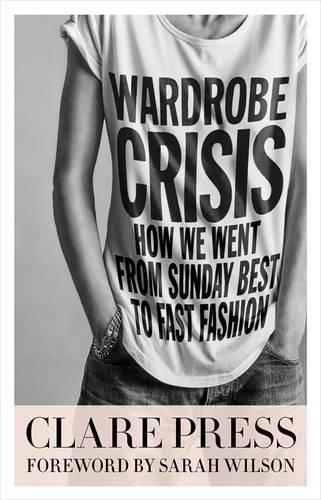Wardrobe Crisis: ethics, sustainability & the fashion revolution
Our digital marketing manager (and fashion enthusiast) Lian Hingee recommends Wardrobe Crisis, in which Clare Press explores the history and ethics behind what we wear.
In 2013 the world was rocked by the powerful images coming out of Bangladesh in the aftermath of the Rana Plaza building collapse that killed over 1,100 people. The tragedy sparked a world-wide conversation about corporate social responsibility, and the true cost of ‘fast fashion’. Three years later, and the issue of sweatshops is back in the spotlight with the launch of Fashion Revolution’s #WhoMadeMyClothes social media campaign, and the release of the Australian Ethical Fashion Report.
I like clothes. I write a fashion blog and I joke about having a shopping addiction. I’m one of those people who constantly refreshes their wardrobe, whose eyes light up when they see a great deal, whose first instinct when there’s a special occasion is to buy something new rather than wear something old. And as much as it pains me to admit it, I’ve never really questioned where it all came from. In short… I’m the perfect target market for Clare Press’ engaging and educational new book, Wardrobe Crisis.
Clare Press is the fashion editor at Marie Claire, and has worked as a brand consultant and designer. This all means she knows more about fashion than I could ever hope to learn. Her chatty and conversation writing style grabbed me right from the beginning, and I found her reflections on her own fashion addiction charmingly self-deprecating. (She also has a cat, Pix, who rates a mention in the book so I’m pretty sure we’d be best buddies if we ever met.)
In many ways, the fashion world is a fun-house, a carnival ride, all smoke and mirrors: Galliano trying to strip a hobo on the street for his perfect haute homeless collection in 2009, Lagerfeld’s Chanel supermarket of 2014 where you could buy a metal shopping basket for a cool $14,000. But alongside the glamour, there’s something else and Press doesn’t shy away from the grubbier side of this industry that has been exploiting workers, animals, and environments since it began. The chapter on fur production is sickening, and especially relevant as fur is currently enjoying a resurgence in popularity (I’m looking at you Kim Kardashian, and you too not-actually-vegan Beyonce). The chapters on the conditions endured by workers throughout the history of fashion production are equally distressing. It’s clear the industry obviously hasn’t learned any lessons from tragedies like the Triangle Shirtwaist Factory Disaster which cost 146 lives in Manhattan in 1911 – they’ve just moved it offshore: out of sight, out of mind.
Wardrobe Crisis is entertaining and enlightening, and thankfully, it’s hopeful too. Press writes about a growing focus on sustainable and ethical fashion within the industry, and in the latter half of the book, she urges us to consider a better future. It’s a future where science allows us to create new textiles, where the demand for cheap clothing doesn’t come at the cost of worker’s lives, and where consumers embrace the idea of fashion as an investment: to be used, re-used, mended and handed-down. I, for one, like the sound of this.



